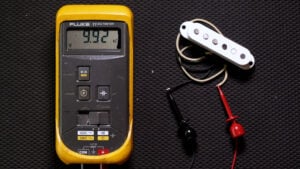Video by Trey via YouTube
Source
If you’ve shopped for guitar pickups, you’ve probably noticed a line listed in the product description that specifies “DCR.” But what exactly is DCR, and what does it mean in relation to guitar pickups?
If you ask another guitarist, they may have an answer for you—and they’d probably be wrong. Or, at the very least, not exactly right.
Guitarists are often told that the higher the DCR—which stands for Direct Current Resistance—the louder the pickup. But Kevin Beller, Seymour Duncan’s V. P. of Engineering, says this isn’t totally accurate.

Kevin Beller, Seymour Duncan’s V.P. of Engineering
“Misinformation is rampant on the topic of DCR,” he told us.
To be clear, DCR is an important measurement for those working with guitar pickups, but to simplify it as the output or volume of pickups doesn’t tell the whole story. So, let’s set the record straight with a little help from an expert. Keep reading to learn the ins and outs of DCR and what it means for your guitar.
What is DC Resistance?
DC resistance (which we’ll shorten to DCR from here on out), is a measurement of how easily current runs through an object. It is affected by the material itself (e.g., poly-coated copper wire), the material construction (e.g., 42 American Wire Gauge), and the material’s length (e.g., 3,000 feet of wire).
A lower DCR means that voltage will pass through an object with more efficiency. From a raw materials standpoint, silver has the lowest DCR followed by copper, assuming the same construction and length. Meanwhile, wood and hard rubber have very high DCRs, as voltage doesn’t easily travel through them.
What DC Resistance Tells Us About Guitar Pickups
The material, construction, and length in the previous section’s example on calculating DCR aren’t random—they’re the ingredients of a guitar pickup. We use thousands of feet of copper wire in our pickup winding process.
As for what that means with regards to DCR, we’ll let our own Seymour W. Duncan take it away.
“The DC resistance is basically telling you what the resistance is for the length of wire being used on that particular pickup.” Seymour W. Duncan
That’s basically it. You’ll notice that Seymour doesn’t mention output at all in his explanation on what DCR means for guitar pickups. That’s because, when it comes to pickup output, DCR is only one part of the equation.
What Affects Pickup Output?
To understand what affects output in guitar pickups (how loud they can be), it helps to know a little about pickup construction.
A guitar pickup is made of one or more magnets wrapped in wire, held in place by a plastic bobbin. As we explain in our article “What is a Humbucker,” the combination of magnets creates “a magnetic field around the strings, and in turn [induces] a small electrical current in the coils as the guitar strings vibrate.”
The raw output of a pickup is going to be determined by the construction (single coils, stacks, humbuckers), magnet or magnets (ceramic, Alnico), the type of wire used (copper), the thickness of the wire (AWG 42, 43, 44), and how many times the wire is wrapped around the bobbin (length of the wire).
Wire Gauge and Number of Winds
As Seymour W. Duncan explained to us earlier, DCR simply tells us what the “resistance is for the length of wire being used.” So, what happens when you change the wire?
“The DCR will increase,” according to Kevin Beller. “Using a finer gauge of magnet wire—for example, moving from 43 to 44 AWG on otherwise identical pickups—will cause the DCR to go up.”
But this still doesn’t mean much when we’re talking about output. “That’s a case where DCR can be misleading,” Beller explains. “The pickup with the thinner magnet wire will have a higher DCR, but that doesn’t necessarily change the output. It’ll change the tone, but not the output.”
Magnets
One of the big factors in pickup output is magnet strength. “There’s a linear relationship between the gauss strength—the magnet strength—and the amount of output,” according to Kevin Beller.

Two pickups with the same DCR but different magnets will have a different output. For example, Alnico 2 naturally has a lower voltage output than Alnico 5, and Alnico 5 has a lower voltage output than ceramic magnets. “Generally speaking, if everything else is equal in the pickup and you take the Alnico 2 out and put a ceramic in, it’ll have more output [even though the DCR stays the same]”
Pickup Construction
The same goes for construction. “Let’s take, for example, a stacked pickup vs. a single coil. The stack could have the same (or higher) DCR as a single coil, but the single coil would have higher output,” Kevin Beller explains. “This is because half of the stack is canceling output, which isn’t happening at all with the single coil.”
You can look at a few of our pickup sets to help understand this a bit better. First, let’s turn to our Custom Flat Strat set with Alnico 5 magnets. The DCR of the neck is 12.27k, the middle is 12.8k, and the bridge is 13.3k. The bridge has a slightly higher DCR, but they’re all pretty close.
Now, look at our Cory Wong Clean Machine set (two single coils and a stacked bridge). DCR will read 7.05k in the neck, 7.15k in the middle, and 14.54k in the bridge. This doesn’t mean that the bridge pickup is twice as loud as the neck and middle because stacks can have higher DCR and still have a lower output.
“You may look at our Vintage Stack and see the DCR is close to 20k and think ‘Oh, this is going to be really hot.’ Well, it’s not at all,” Beller explains. “It’s more like a vintage output. There are probably single coils that read 6.5k that are hotter.”
What is DCR Good For?
So, how can you, as a guitarist, use DCR when evaluating pickups?
Though higher DCR doesn’t always mean louder, it can mean exactly that. DCR isn’t especially helpful in comparing apples to oranges, but it is relatively helpful when comparing apples to apples. “Let’s say you’re just looking at humbuckers with Alnico magnets,” Beller posits. “Generally speaking, as the DCR goes higher, the output will go higher with it.”
DCR can also affect the tone of a guitar pickup. In general, higher DCR means you start to lose some of your top-end. But this isn’t necessarily a bad thing! For example, ceramic magnets are often described as “brighter” than Alnico magnets. By increasing the DCR of a guitar pickup with a ceramic magnet (through overwinding or changing the wire gauge) we can mellow that high-end for a more balanced frequency response.
Another way guitarists can use DCR is not for shopping, but for testing the functionality of their pickups. As we touch on in our article “How to Test Guitar Pickups with a Multimeter,” knowing DCR can help you troubleshoot fussy pickups.
If you suspect your pickups aren’t working as they should, you can pull them out of your guitar and see if their DCR is close to what’s listed on a product page. If their readout is more than a little different, you may have an issue. If your pickups are reading fine, you may want to check other elements of your wiring or overall signal chain to diagnose the issue.
What’s the Best Way to Determine Pickup Output?
By now, we’ve established that DCR alone is not the best to determine pickup output. Even though DCR can help us compare like pickups—e.g., Alnico 2 humbuckers vs. Alnico 2 humbuckers—there’s still a big blank space in determining which of two pickups with dissimilar construction or magnets has a higher output. The biggest one being that pickup manufacturers don’t usually publish wire length, wire gauge, impedance, and other elements that contribute to output.
But one thing we do publish at Seymour Duncan is a Salsa number.
Similar to how a jar of salsa has a spiciness scale, our pickup pages feature an output scale. For each pickup, you can see if it ranks on the low (10) or high (100) end of our salsa scale, with a larger number being a louder pickup.
And we’re not just running on vibes here. We conduct tests to determine pickup output.
“We put the pickups in a special guitar equipped with a mechanical strum arm,” Kevin Beller explains. “The arm is spring-loaded, pivots on precision ball bearings and has a spring steel pick. The pickup height is then set precisely using pin gauges. Then the arm is pulled back to the stop and released across the strings. We then read the instantaneous output on a digital storage oscilloscope.”
This isn’t to say our Salsa number is an industry standard—other manufacturers may have different systems that don’t correlate with ours. “We’ve done a lot of experimenting to develop our system and to get the Salsa numbers we publish,” Beller tells us. “We always get consistent results and feel that they are directly proportional to output. They ignore the other differences and exclusively look at what the pickup puts out when you strum a chord.”
So, there you have it. If you’re simply interested in the highest output you can get, or if you’re looking for a specific range, “the Salsa number is a much more accurate indicator than looking at DCR,” Beller concludes.
The post Understanding DCR: Pickup Resistance vs. Output appeared first on Guitar Pickups, Bass Pickups, Pedals.
